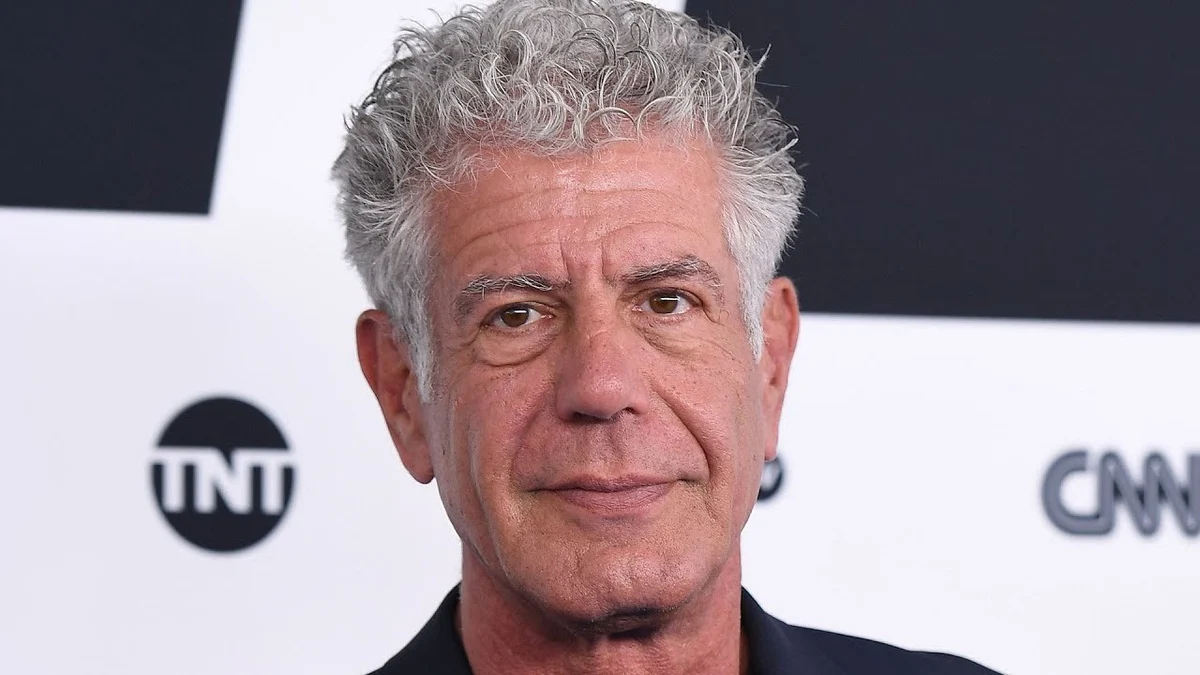Anthony Bourdain didn’t just travel for the sights—he traveled for sandwiches. For him, food wasn’t just something to taste. It was a full-blown cultural trip. A pastrami on rye in New York. A meat-laden Francesinha in Portugal. Mortadella folded high in Brazil. Iconic sandwiches weren’t random stops on his map—they were moments that captured everything …
Anthony Bourdain’s Favorite Sandwich A Taste of Culinary Genius

Anthony Bourdain didn’t just travel for the sights—he traveled for sandwiches. For him, food wasn’t just something to taste. It was a full-blown cultural trip. A pastrami on rye in New York. A meat-laden Francesinha in Portugal. Mortadella folded high in Brazil. Iconic sandwiches weren’t random stops on his map—they were moments that captured everything he believed in: authenticity, flavor, respect for tradition, and curiosity for the new. These weren’t fancy, Instagram-ready plates. They were messy, melting, bold creations that told stories.
So why are Anthony Bourdain’s favorite sandwiches still relevant?
Because they sit right at the sweet spot between high-level culinary technique and everyday food joy.
This isn’t about showing off with gold-plated truffles. This is about tasting the culture of a place in one bite.
From his NYC nostalgia bites to down-to-earth street food vibes, here’s a deep dive into the sandwiches Bourdain not only loved—but helped immortalize in food culture.
Anthony Bourdain’s Timeless Culinary Legacy Through Sandwiches
Anthony Bourdain made food personal. And when he talked about sandwiches, it wasn’t just about flavor—it was about value, story, and soul.
His whole career spotlighted one thing above all: respect.
Respect for ingredients.
Respect for culture.
Respect for people doing it right their whole lives—chefs, stall vendors, old-school sandwich shop owners.
He had a type when it came to meals: he loved the deeply authentic stuff.
And sandwiches? They were his way of proving you didn’t need white tablecloths or Michelin stars for food to matter.
Whether it was the humble bread-and-meat combo crafted at a market stall or a decades-old NYC deli counter sandwich, Bourdain elevated these meals without pretending to “fancy” them up. He showed the world that a sandwich could be a culinary masterpiece if it honored its roots and nailed the flavors.
So, what made his sandwich choices iconic?
It wasn’t just about taste—it was about roots.
He looked for creations that held a story in every layer:
- Sandwiches steeped in local tradition
- Ingredients that honored generations of technique
- Bold combinations that somehow just worked
When Bourdain sat down with a sandwich, you weren’t just watching someone eat—you were watching him discover identity, place, and people.
Celebrity Cuisine Sandwich Legacy – The Role of Sandwiches in Food Culture
You’re probably thinking—how can a sandwich even be part of celebrity cuisine?
Here’s how: sandwiches live in this gold zone between comfort food and cultural significance. They’re fusion. They’re family. They’re freedom on a plate.
Bourdain treated them as serious culinary work, bridging casual and high-end dining without breaking stride.
He helped flip the narrative—no longer were sandwiches seen as just lunch options. They became stories worth telling.
In his world, the best meals weren’t the most expensive—they were the ones that hit the deepest. That’s what sandwich culture is all about.
Let’s break it down:
| Dish | Location | Cultural Significance |
|---|---|---|
| Pastrami Sandwich | New York City | Quintessential deli tradition, NYC roots |
| Mortadella Sandwich | São Paulo, Brazil | Hearty market fare, bold flavor profile |
| Banh Mi | Hoi An, Vietnam | French-Vietnamese fusion, crisp textures |
Whether it was grilled bologna at Wilensky’s or towering mortadella in São Paulo, Bourdain put these sandwiches on the map for global audiences. And it wasn’t about hype—these dishes carried real local identity.
He wasn’t just boosting flavor combos—he was anchoring them in the broader narrative of food culture.
So yeah, sandwiches went from being pantry throw-togethers to vessels of social storytelling.
Bourdain’s Favorite Sandwiches And Their Backstories
Pastrami Queen in New York wasn’t just another stop on Bourdain’s map—it was muscle memory.
Post travel, post filming, when Bourdain found himself back in the city that shaped him, he craved that specific hit of East Coast nostalgia. And for him, that meant a hot pastrami sandwich from this no-frills deli on Lexington Ave.
Here’s the magic:
Warm, fatty-yet-balanced pastrami, sliced thick.
Soft but structured rye bread.
Tangy mustard acting like the glue.
And let’s not forget—the perfect crisp pickles on the side.
He once called this setup a “quintessential New York meal,” and he wasn’t exaggerating. Each bite took him back—back to dinner counters, late-night city noise, and real-deal flavor bombs crafted with care.
Bourdain didn’t just eat the sandwich—he honored it. The layers, the textures, the tradition. It was the blueprint for timeless sandwich technique. That perfect fat-to-lean ratio? It wasn’t by chance. It’s what made this seemingly simple dish a benchmark in the celebrity cuisine sandwich legacy.
Now let’s slide over to São Paulo.
That mortadella sandwich from Bar do Mané? Game changer.
First of all, the size alone could intimidate even the hungriest appetite. But when Bourdain recreated it in his own style, he made it more than a hearty snack—it became a flavor bomb.
His remix:
– Pan-fried mortadella with crispy edges
– Melted provolone cheese dripping over the sides
– Dijon mustard for that punch
– Mayo for creaminess
– All sitting on a toasted sourdough or crusty Kaiser roll
He called it “a beloved heap of oozing awesomeness,” and within that phrase lies the soul of Bourdain’s food approach: fun, messy, and inventive.
Not everything had to be a polished plate. Sometimes, greatness came in stacks of meat, melting cheese, a killer condiment combo, and the right kind of bread hug.
That’s what made his food legacy different. It wasn’t about being elite—it was about being real.
Global Gastronomic Exploration in Bourdain’s Sandwich Choices
Anthony Bourdain wasn’t just a chef–he was a cultural translator. Every bite, every flavor, and especially every sandwich he featured in his travels told a deeper story about the places and people behind them. Sandwiches weren’t just something thrown together for convenience in his world. For Bourdain, they were layered—with meat, culture, and meaning.
What made his food journey so captivating was how real it was. He didn’t chase luxury for the sake of it, but hunted down flavor. Authenticity was the heart of his culinary compass. Whether enjoying a $2 street snack or a beloved local classic, Bourdain focused on how food brought communities together—and nothing captured that better than his favorite sandwiches.
Sandwiches, after all, are universal. Every culture has their own spin on stuffing delicious fillings between bread. And Bourdain highlighted that with flair. Take the Vietnamese banh mi, for example. When he visited Banh Mi Phuong in Hoi An, Bourdain praised the sandwich for being “a symphony in a sandwich.” That crusty baguette? Light and airy with the perfect crunch. But it’s about what’s inside, too—pickled veggies, pate, meats, herbs, and a spike of chili heat. It was flavor, texture, and culture all in one bite.
In other places, sandwiches went heavy on the comfort. The Francesinha in Porto, Portugal, was full-blown indulgence—cheese-covered, meat-packed, and smothered in beer sauce. Bourdain didn’t just eat it; he admired the culinary guts it took to put steak, sausage, AND ham between two slices of bread and call it a meal.
In every corner of the globe, from Montreal to São Paulo, Anthony Bourdain’s sandwich picks offered more than just good eats—they revealed how people live, love, and feed themselves every day. They were an edible passport stamped with experience, grit, and pure culinary joy.
Bourdain’s Artistry: A Modern Twist on Classic Sandwiches
Anthony Bourdain wasn’t content with sticking to the classics—he pushed the boundaries of what a sandwich could be. Sure, he respected the roots, but he also dared to give those age-old recipes a bold, modern makeover. For him, sandwiches were a playground for creativity—where old-world flavor met fresh, edgy twists.
He didn’t just eat the food—he celebrated it. Bourdain took traditional recipes and made them matter to a new generation of food lovers. Think artisanal ingredients, strategic flavor pairings, and presentation that made even the simplest dish feel elevated.
The Francesinha at O Afonso in Porto, Portugal? Pure Bourdain storytelling. This mammoth sandwich came stacked with ham, smoky sausage, and seared steak, all cloaked in gooey cheese. But the real kicker? A spicy beer and tomato sauce—poured over the top like culinary lava. Bourdain called it “the immortal combination” and marveled at the engineering of it. It wasn’t just indulgent—it was genius. He recognized the boldness of it, the cultural pride it represented.
And then there was the “Wilensky’s Special” in Montreal. So simple, but so powerful—just grilled beef bologna on a flat roll, always served with mustard, never cut in half. This Canadian classic was more than nostalgia on a plate. For Bourdain, it was authenticity at its finest. Food that didn’t pretend. His show “Parts Unknown” gave it the spotlight, and fans flocked to try this understated legend for themselves.
Whether it was stacked high or kept barebones simple, Bourdain had a unique gift: he made you see sandwiches for what they truly were—affection, creativity, and culture you could hold in your hands.
Here’s how Bourdain’s sandwich magic stood out:
- Respect for roots: He didn’t erase tradition—he amplified it.
- Bold flavors: From rich sauces to smoky meats, his sandwiches were never boring.
- No snobbery: Whether fine dining or street food, it was all about taste.
- Grit meets gourmet: Bourdain never polished away what made food real.
His innovation left a legacy that still ripples through kitchens and menus today. And it all started with something as seemingly humble as a sandwich.
Inside Bourdain’s Sandwich Recipes
One sandwich that truly personifies his culinary genius? The mortadella sandwich Bourdain crafted after visiting São Paulo’s legendary Bar do Mané. It’s not just a sandwich—it’s a juggernaut of richness and finesse.
He came back from Brazil inspired and turned that spark into a sandwich you could pull off at home—but only if you respected the details.
Want to recreate Bourdain’s mortadella sandwich? Here’s what you need:
- Mortadella: Pan-fried until crispy on the edges
- Provolone cheese: Melted flawlessly over hot mortadella
- Dijon mustard: Sharpness to cut through all that richness
- Mayonnaise: Just enough to add creamy contrast
- Toasted sourdough or Kaiser roll: Holds everything together without falling apart
According to Bourdain, pan-frying the mortadella brought out its hidden complexities. Once sizzling and golden, it layered perfectly with the gooey provolone. Add the condiments, a perfectly toasted bun, and you’ve got what he called a “beloved heap of oozing awesomeness.”
And it wasn’t just about this one sandwich. His technique influenced home cooks and chefs alike. Bourdain showed us that making killer sandwiches isn’t about excess—it’s about precision.
Bourdain-style sandwich hacks include:
- Layer smart: Put wet ingredients like mayo in between dry meats to avoid soggy bread
- Toast with intention: Choose bread that can handle heat and moisture
- Pick condiments that matter: Swap generic mustard for Dijon, add a twist like aioli or chutney
These touches may seem small, but that’s what Bourdain was all about—maximizing flavor, respecting culture, and never taking shortcuts when it came to taste.
His mortadella creation wasn’t just another grilled sandwich—it was a statement. A delicious one.
Timeless Sandwich Techniques and Ingredients
Think making a sandwich is just about slapping meat between bread? Think again. Anthony Bourdain turned that idea on its head. He viewed a sandwich as a canvas — every piece mattered.
For Bourdain, crunch was essential. The bread needed resistance, a bite that held its own against the filling. No soggy mess. He loved a good structure — soft, savory meats tucked into airy yet crisp bread. Take the banh mi he raved about in Vietnam: that fresh baguette didn’t just hold the ingredients. It made them sing.
Freshness? Non-negotiable. Bold flavors? Even more vital. Bourdain didn’t mess around with weak mustard or pale cheese. He chased meaning in every bite. The mortadella sandwich inspired by Bar do Mané in São Paulo had barely five ingredients, yet it exploded with character — pan-fried goodness, melted provolone, sharp Dijon. That wasn’t just a snack. That was a statement.
- Crunch-to-soft ratio: Bread must contrast with filling — always.
- Heat matters: Warm fillings elevate the sandwich experience.
- No shortcuts: Use full-flavored condiments and real pickles, not grocery store stand-ins.
Now here’s the wild part — Bourdain’s takes kicked off a ripple effect. Chefs across the globe began reimagining street food and humble sandwiches. In a world chasing fusion and foam, artisans returned to basics.
Thanks to Bourdain’s approach, today’s best sandwich spots are mastering time-honored techniques, dialing in on balance and flavor. He didn’t invent the grilled cheese, but he sure taught us how to elevate it.
Celebrating Niche Flavors and Culinary Traditions in Sandwiches
Walk through Hoi An’s street markets and you’ll smell it before you see it: the banh mi at Banh Mi Phuong. Bourdain called it “a symphony in a sandwich” — and he meant it. Crispy, delicate bread giving way to layers of meat, pickled vegetables, herbs, and silky pâté. It wasn’t just lunch. It was cultural immersion.
What made this so special to Bourdain — and why it sticks with us — was its total authenticity. Locals had been making that sandwich for decades, without ever calling it “artisanal.” It just was. The flavors were raw, honest, and rooted in something deeper than a foodie trend.
That’s the legacy of Bourdain’s favorite sandwiches: they weren’t about chef ego or four-star luxury. They celebrated real places and real traditions. He spotlighted sandwiches that meant something to the communities making them, from New York’s pastrami on rye to Portugal’s rich, saucy Francesinha.
And here’s the kicker — this spotlight changed how people ate. Suddenly, global food lovers were chasing those same flavors. Not for Instagram, but for the experience. They weren’t just grabbing lunch. They were hunting down meaning between slices of bread.
Today, you can find cooks recreating that Banh Mi Phuong flavor in the middle of Los Angeles or replicating Wilensky’s Special in a Brooklyn pop-up. Because when Bourdain said something hit deep? People listened.
The Epic Legacy of Anthony Bourdain’s Favorite Sandwiches
Why do Bourdain’s sandwiches still matter? Because they nailed a rare sweet spot — where comfort food meets culinary craft. He didn’t care if it cost $3 or $30. If it triggered nostalgia while still surprising the tongue, it earned his love.
Look at Pastrami Queen in New York. That pastrami wasn’t dropped on a plate last-minute. It was curated — “a nice mix of fat and lean,” as Bourdain said — served warm, never cold, with real rye bread and properly brined pickles. It’s the kind of meal that reminds you where you came from.
Same goes for the Francesinha in Porto. That’s not a dainty finger sandwich. It’s an unapologetic pile of meat, cheese, and bread doused in beer sauce, and Bourdain ate it with wide-eyed glee. That wasn’t just appetite talking. It was reverence.
These sandwiches still hit today because they blend two things we all crave — familiarity and inspiration. They take something we know (meat + bread) and inject it with cultural depth, craftsmanship, and straight-up flavor.
And yeah, Bourdain’s gone. But his food philosophy? Very much alive. You see it in chefs who honor local ingredients. In sandwich shops that care more about technique than TikTok trends. In home cooks trying their own version of his mortadella masterpiece.
He didn’t just show us food. He passed us the torch.
Now people replicate his recipes for more than taste. They do it to remember him, to pass on that love of bold flavors and human stories. From street vendors in Vietnam to Euro pubs in Lisbon and delis across NYC — the ripple of Anthony Bourdain’s favorite sandwiches echoes everywhere.
And every time someone takes that first bite — the creamy mayo hitting the crackling bread, the warmth of the meat settling in — he’s there. Still teaching. Still tasting. Still making us hungry for more.






